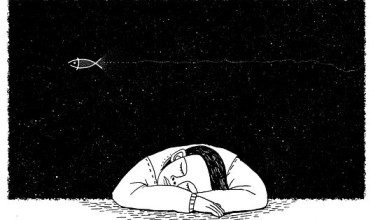
Auto Wreck, a poem by Karl Shapiro composed of 39 lines and split into 4 stanzas has a road accident as the subject of focus. The entirety of the poem focuses on what its title succinctly states – an auto wreck. However, the descriptions and varied perspectives create a well-rounded and thought-provoking interpretation. Shapiro is no stranger to violence and gory visuals, as he served in the Second World War and has written war poems based on the lasting trauma. His experiences are clearly reflected in the detailed description of the accident, as well as his comparisons of death by car accidents to other means of death in the final stanza of the poem. Auto Wreck is rich in imagery and metaphors– this is what gives it life and evokes a range of emotions within the reader.
The poem begins with a description of an ambulance rushing through the street- it’s silver bell, and the way the red light flashes in the dark like a pulsing artery. The ambulance is at top speed, passing the beacons and buildings. As it reaches its destination, entering the crowd surrounding the patient, its doors open immediately to reveal the stretchers. The injured person is lifted into the ambulance, and the bell rings one more time before the vehicle is off again. Filled with cargo and the patient, it rocks slightly as it drives away, the doors closing.
The second stanza switches perspective from third to first-person. The poet describes many people, including himself, feeling deranged at the sight of the accident. They stand among the cops who sweep the broken glass and make notes under the light. One cop empties the remaining blood into the gutter, while the other hangs lanterns onto the remaining wreckage that clings to the iron poles.
The description continues in the third stanza. The poet describes their- the onlookers’- tight throats and disbelief at the accident they witnessed. Now, they speak through sickly smiles, as if trying to lighten the mood after their shock. The traffic continues, avoiding the accident-hit area carefully, but the crowd remains at the site. The view of the physical wound opens the depths of their mental wounds to dark possibilities and thoughts- already aging, they wonder who will die and who is innocent.
In the final stanza, the poet compares the death he just witnessed- in a car accident- to death by other means. In war, one dies at the hands of another. With suicide, there is a cause, and with stillbirth, there is a scientific explanation. With illnesses such as cancer, the tumor grows in the body and renders it helpless. But this kind of death, death through a road accident, cancels all the logic they have known. Accidental death does not allow for the tying up of loose ends– it throws the victim unexpectedly haywire, across the wicked and expedient stone.
Auto Wreck | Analysis
An important element is the perspective switch in the narration- it begins in the third-person, describing the ambulance on its way to the accident area, but then switches to the narrator’s perspective. The main themes are shock, reality, death and the human viewpoint on normality and life sequence. The poem is written in present-tense. In fact, while reading, it almost runs like commentary- it starts with an establishment of context, and then shifts to a more personal point of view. Interestingly, this poem does not follow the patient, but rather a witness- it observes the shock and thought-altering effects that can occur to one who has witnessed an accident. The narrator is not hugely connected to the accident- probably still reeling from unbridled disbelief– and thus narrates the surroundings and his feelings in a very logical and detached manner. This is why the incident is narrated so straightforwardly- rather than grief, pain or emotional distress, Shapiro focuses on shock-induced thoughts and a reality-check.
Auto Wreck | Analysis, Lines 1 to 7 (Stanza 1)
“Its quick soft silver bell beating, beating,
And down the dark one ruby flare
Pulsing out red light like an artery,
The ambulance at top speed floating down
Past beacons and illuminated clocks
Wings in a heavy curve, dips down,
And brakes speed, entering the crowd.”
Shapiro begins with imagery. This is a clever way to establish the setting and context, as readers are able to form a clear picture in their mind. In the description of the speeding ambulance, Shapiro uses certain words and details that link it to the injured victim of the accident. For example, he uses repetition for emphasis on the word “beating”. This not only strengthens the emotional impact, but is also a connection to the beating of the heart. While the bell of the ambulance is beating quickly, it is most likely that the heartbeat of the injured person is slowing down. Similarly, the “ruby flare” is the red light atop the ambulance. Shapiro compares it to an artery, once again a link to the injured person whom the ambulance is approaching. An artery compares to the ambulance light because of the color, and to the victim because it symbolizes blood and blood loss– consequently, injury. The line “And down the dark one ruby flare” confirms that it is nighttime.
In the line “Wings in a heavy curve, dips down,” wings are used to depict the ambulance’s speed. This also arouses a tension and nervous impatience in the readers, further establishing the seriousness of the situation. The detailed description of the ambulance- especially the silver bell, “floating down” and the wings- likens it to the image of an angel. Thus the ambulance may represent an angel going to save a victim from death. Finally, the ambulance arrives at the scene of the accident. “Entering the crowd” implies that many people have gathered around the area of the crash.
Auto Wreck | Analysis, Lines 8 to 14 (Stanza 1)
“The doors leap open, emptying light;
Stretchers are laid out, the mangled lifted
And stowed into the little hospital.
Then the bell, breaking the hush, tolls once.
And the ambulance with its terrible cargo
Rocking, slightly rocking, moves away,
As the doors, an afterthought, are closed.”
There is a personification in the first line- the doors are given the humanistic action of “leaping” open to signify how quickly they are opened to accommodate the patient. While the “emptying light” means that the light from inside the vehicle is dispersed into the darkness of the night, it also signifies the victim’s depleting state. The light symbolizes the person’s life, and the “emptying” means their condition is getting worse. The “little hospital” in the third line is none other than the ambulance itself- it contains all the basic first aid, and is sent directly from the main hospital.
This stanza balances stylistic and direct elements. While there are anticipation-inducing sentences such as “Rocking, slightly rocking, moves away, As the doors, an afterthought, are closed.”, the poet uses the word “mangled” to describe the injured person, which is quite a raw expression. Further, in the line “And the ambulance with its terrible cargo” we may assume that the poet is referring to all the instruments and materials stored in the back of the ambulance. However, on rereading, it occurs to us that the patient is never mentioned as a separate entity- meaning the cargo might as well include the patient. This signals that the injured is slowly losing their life, and their body is simply adding on to the freight. The doors which close as an “afterthought” highlight the finality of the action and the fatality of the injured.
Auto Wreck | Analysis, Lines 15 to 21 (Stanza 2)
“We are deranged, walking among the cops
Who sweep glass and are large and composed.
One is still making notes under the light.
One with a bucket douches ponds of blood
Into the street and gutter.
One hangs lanterns on the wrecks that cling,
Empty husks of locusts, to iron poles.”
Here, we see a perspective change. The poem shifts from third-person to first-person narration. Also, from the word “we”, it is shown that the narrator is part of the crowd surrounding the accident, and that his words represent the crowd in general. “Deranged” is a strong usage, meant to convey the intensity of their shock. They are not able to think straight after witnessing such a horrific accident- nothing seems to make sense. On the contrary, though, the police are functioning almost nonchalantly, like they are used to the sight. They are described as “large and composed” which confirms how calmly they handle the situation. This is further emphasized with the lines “One with a bucket douches ponds of blood Into the street and gutter.” The action itself is almost disturbing, but the narrator describes the cop’s actions with ease- they are just doing their job. The fact that the blood is thrown into the gutter– typically a place for waste and sewage water- is a disturbing reality of what comes after death or an accident.
The contrast between the feelings of the crowd- in a stunned state- and the police who are functioning ordinarily, is specifically used to highlight the cycle of life and death. The crowd represents the shock which comes with an unexpected passing, while the police represent the unavoidable normality of death. In the last two lines of the stanza, the narrator compares the wreckage of the car to empty husks of locust as it clings to the iron poles. From this, we may assume that the accident was caused by a car crashing into a street pole.
Auto Wreck | Analysis, Lines 22 to 27 (Stanza 3)
“Our throats were tight as tourniquets,
Our feet were bound with splints, but now,
Like convalescents intimate and gauche,
We speak through sickly smiles and warn
With the stubborn saw of common sense,
The grim joke and the banal resolution.”
Shapiro employs a simile in the first line of this stanza. Tourniquets are usually tied tightly around an injury on the leg or arm to prevent blood. It is also tied above the area of snake bites to prevent the venom from spreading towards the heart. This comparison highlights how the narrator and the crowd felt while watching the scene- throats so tight that they are unable to speak. This may be both from the trauma of witnessing the accident as well as witnessing the cleaning of a public crash- it also hints at how quickly the entire sequence must have happened, to the point that the crowd is still unable to wrap their heads around it.
The crowd was originally frozen in place, possibly from fear. But now, as time has passed since the accident and the police are on the scene, they slowly attempt to bring their mind back from the horrific image. The narrator compares themselves to convalescents- people recovering from illness or injury, in this case alluding to the mental recovery from shock– feeling awkward in a social situation after what they have witnessed. They try to lighten the mood by smiling, despite the gravity of the situation. They attempt to make comments, which the narrator calls “grim jokes” because they are mostly likely of dark humour, or are not sincere- such ‘jokes’ are simply made to cope with shock and discomfort.
Auto Wreck | Analysis, Lines 28 to 32 (Stanza 3)
“The traffic moves around with care,
But we remain, touching a wound
That opens to our richest horror.
Already old, the question Who shall die?
Becomes unspoken Who is innocent?”
“The traffic moves around with care” is an extremely important line because it represents exactly how the rest of the world views a car accident. The injured person and their family suffer great pain and loss. The people who directly witnessed the accident are likely to experience fear and trauma. But for the rest of the world, who just view the unfortunate scene as they pass on the road, are simply sympathetic. They cannot relate to the accident, nor feel the disbelief of witnessing it first-hand. The former part of the line- “the traffic moves around”- signifies how life moves on after such a terrible occurrence, as is the cycle of life. While “with care” represents sympathy. People may feel bad on seeing the wreckage, but there is nothing they can do, and the incident is not likely to remain in their mind for very long as they continue with their lives.
The narrator then says “but we remain.” As mentioned earlier, witnessing a death provides an enormous shock to the system. On directly seeing how quickly life can slip away, it is possible that the crowd will also be more paranoid about everyday activities such as driving or walking near cars on the road. “Touching the wound that opens to our richest horrors” references the physical wound of the mangled individual, but means something entirely different: the narrator is talking about the dark questions which are hidden in the back of one’s mind, their greatest fears– mental wounds formed by questions about death. It is an unspoken but common doubt amongst all the witnesses- who will die? Who will live? In such a situation, who is innocent or guilty? The rhetoric tone also induces a feeling of helplessness within the readers, akin to how the narrator feels in the situation.
Auto Wreck | Analysis, Lines 33 to 39 (stanza 4)
“For death in war is done by hands;
Suicide has cause and stillbirth, logic;
And cancer, simple as a flower, blooms.
But this invites the occult mind,
Cancels our physics with a sneer,
And spatters all we knew of denouement
Across the expedient and wicked stones.”
The final stanza elaborates on the narrator’s previous question, and also wraps up the scene of the accident. The narrator thinks about the different possible modes of death, in comparison to the one he just witnessed. On the war field, one dies at the hands of another. Hence one is guilty of killing another- there is a person to blame. Similarly, with suicide there is a cause and with stillbirth there is an explanation. And cancer is an illness, also biological- hence there is a scientific answer. “Simple as a flower, blooms” is used to describe the multiplication of the tumor in the body.
The lack of closure that comes with an accidental death is the biggest aspect of confusion and fear to the narrator. As he asked in the previous stanza “Who is innocent?” Because in the other modes of death, there is no explanation required– the answer to all of these deaths is relatively obvious. There is a cause, a reason, and a sense of closure. But this car accident is totally unexpected. The injured person did not leave their house that morning knowing it would be their last day on Earth- they likely have a lot they want to accomplish, many things left unsaid, and many loose strings in their life.
This is a shock and a reality check to the narrator. In the line “This invites the occult mind” – occult refers to mysterious or supernatural powers, and the narrator compares this incident to the same because he is unable to explain it with logic. All the logical thoughts are crushed mercilessly at the hands of sudden, unexpected death. The narrator used to associate death with a sense of a full-circle: living life to the fullest, wrapping up all the loose ends, and then passing away. This accident reminds him that this cannot always be the case. “And spatters all we knew of denouement Across the expedient and wicked stones.”- “denouement” means a conclusion of sorts, a clear finale. The final line depicts the way that sudden occurrences such as road accidents throw away any possibility of a coherent conclusion to life. The “expedient and wicked stones” symbolize the stone-cold road which the victim was flung onto after the road accident- just like their physicality, any possible denouement of life was shattered and all that is left are unanswered questions.



